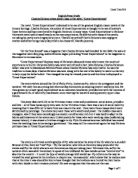Charles Dickens’ novel Great expectations is set in the Victorian period and is highly related to the state of poverty that Dickens encountered on his rise to fame. It concerns the young boy Philip Pirrip (known as ‘Pip’) and his development through life after an early meeting with the escaped convict Abel Magwitch, who he treats kindly despite his fear. His unpleasant sister and her humorous and friendly blacksmith husband, Joe, bring him up. Crucial to his development as an individual is his introduction to Miss Havisham, a now aging woman who has given up on life after being left at the altar. Cruelly, Havisham has brought up her daughter Estella to revenge her own pain and so as Pip falls in love with her she is made to torture him in romance. Aspiring to be a gentleman despite his humble beginnings, Pip seems to achieve the impossible by receiving a fund of wealth from an unknown source and being sent to London with the lawyer Jaggers. In London he meets a number of different and intriguing characters and although he is employed, he eventually loses everything and Estella marries another. His backer turns out to have been Magwitch and his future existence is based upon leaving the great expectations and returning to Joe and his honest layout. Eventually he is reunited with Estella. There have been a number of film adaptations of the novel, the most recent of which completed by the BBC in 1997 yet one of the more popular and well-known adaptations seems to have been the David Lean version in 1944. Through this book Charles Dickens reiterates about how family values overshadow other themes such as wealth, money and social status. The first scene in the text is very prolific to the rest of the story as it introduces two of the most important characters in the rest of the play (Pip and Magwitch) but it also has a great affect on the audience. It builds a great amount of tension and atmosphere using everything in its use, from the sudden actions to the highly descriptive and detailed accounts of the eerie, dark landscapes that also cause a feeling of solitude and isolation from anyone or anything. The landscape has a big effect on the scene because coupled with other attributes of the text; it is the base around which Dickens builds the emotions of the reader into tension. Chapter one is extremely important for a number of reasons. Firstly, we are introduced to Pip’s modest background and we learn that he is an orphan and that he has never known his parents. Pip’s narrative voice is powerful in gaining our sympathy and trust in the novel. Secondly, the plot is set into motion in chapter one by Pip’s meeting with the convict. We know that this character plays a vital role in Pip’s destiny. This destiny is set in motion in chapter one. Thirdly, Dickens beautifully establishes the setting and atmosphere in chapter one. The bleakness of the landscape and the emotions of fear felt by Pip are extremely powerful. All this has been managed to fit in to chapter one which is only a relatively short piece of writing and could be summarized like this. In a typical day a 7-year old orphan known as ‘Pip’ visits his parents graves in a churchyard. It is early evening and fog is drifting in from the nearby marshes. Suddenly a terrifying escaped convict, with shackles still on his leg, seizes him. He threatens to kill Pip if he does not return with food and a file early the next morning. Pip runs in terror back to the forge that he lives in with his strict sister and her simple, kind-hearted husband, the blacksmith Joe Gargery. A major way Dickens creates this type of tension in the text is to shorten the lengths of his paragraphs and especially sentences, as the action gets quicker and more involved.






